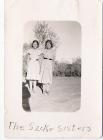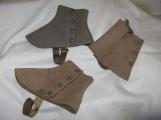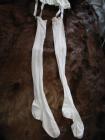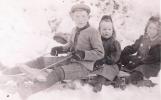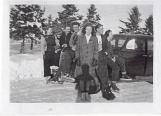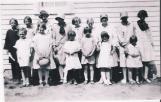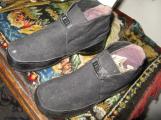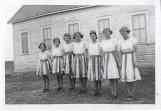1
FashionsClothes children wore to school and at home were usually made by the women of the household. Mothers made underclothes, pyjamas, shirts, dresses, coveralls and coats. Footwear was the only item purchased from a store or the catalogue. Children wore no shoes in the summer time, so this costly item was only needed in the winter. Flour and sugar sacks were boiled in water and lye until nearly all of the advertisement was removed from the sack. These sacks, with advertising removed were made into clothes. Mothers crocheted or tatted yokes and yards of insertion for the blouses. Shirts, overalls and short pants were made for the boys. As money was very scarce a lot of clothing was made from hand-me-downs. Coats were made for boys and girls.
Boy babies wore dresses till they reached a year. (The romper stage) From then until their late teens, boys were dressed in short pants. Money was very scarce in the depression. Blue Ribbon coffee coupons were saved so, a little boy starting school could get a pair of overalls. When a farmer got dressed up he might don a pair of clean overalls and add a suit jacket on top.
In her book, Memoirs of Mary Carritt Nelson, Mrs Nelson, tells how they walked to school in long dresses, and how she sat in class with damp shoes and skirts. These girls must have been really "tough" to be able to withstand the severe winter weather as it was considered improper for a girl to be seen in trousers of any sort. They wore long, heavy, woollen stockings and heavy underwear with long legs and sleeves. None of their clothing was wind or water proof.
One spring in 1928, the girls in grade seven and eight at Bentley School, decided to put their name in Bentley history and shock a few people in town by wearing "ankle socks". They always wore long cotton stockings held up by garters which were fastened to a garter belt. A garter belt wasnít liked by many girls. A few girls rode bare back to school. The horses were usually sweaty and they were also shedding. Can you imagine what their dresses and stockings looked like when they got to school! These girls couldnít understand how the teacher and other pupils could stand the smell. They thought if they replaced the long stockings with bare legs and ankle socks they would smell quite a bit better.Each of the girls had to have a pair of short stockings and they cost twenty five cents. They each worked on getting enough money together to buy the ankle socks.(most parents helped). These girls were determined if one couldnít, none of them would. But eventually they were all ready to make their parade downtown. Some of them felt so naked. After lunch one day, they walked down the street and then back into their classrooms, with lily white legs sticking out from under their hemlines. Some of the ankle socks were colored and had ruffles. These girls felt they paved the way liberating girls into the " bare legged era".
Pants were never worn by girls in public until war time. Women replaced men in the factories and manufacturing outlets. They couldnít work and replace men in these places without wearing pants. Hence, the women started wearing pants in public.
As the country became more prosperous and families had more money, their clothes became more in tune with worldly styles.
The 1920ís brought in many changes, women voting, automobiles, electrical appliances and a change in womenís fashions. Short skirts, 7 to 10 inches below the knee, dropped waistlines and flapper dresses appeared on the scene.
Hats became very popular in the 1930ís. They were back to stay. Ladies applied more makeup to their faces. Spats were worn, above oxfords, by men to keep their ankles warm.
The 1940ís saw the rationing of goods and foods. The motto was, "Make do and Mend".
Now came the 50ís - girdles, nylon stockings, swimsuits, saddle oxfords, plaid pleated skirts, bell bottom pants, empire waist dresses and pull over sweaters. Men could buy and wear pink shirts, plaid and stripped pants.
During all this time the teachers continued to dress very modestly. They were expected to present a respectable image. Ladies never wore slacks. They always dressed prim and proper.
5
Students and Teacher at Sunset School1915
Rural areas around Bentley, Alberta
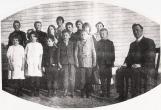 Credits:
Credits:Bentley Museum Society


